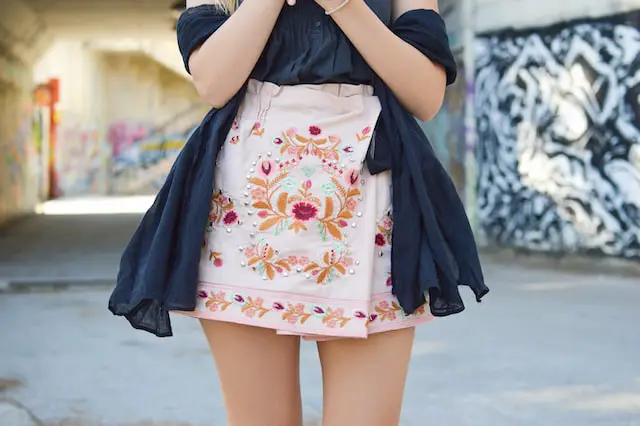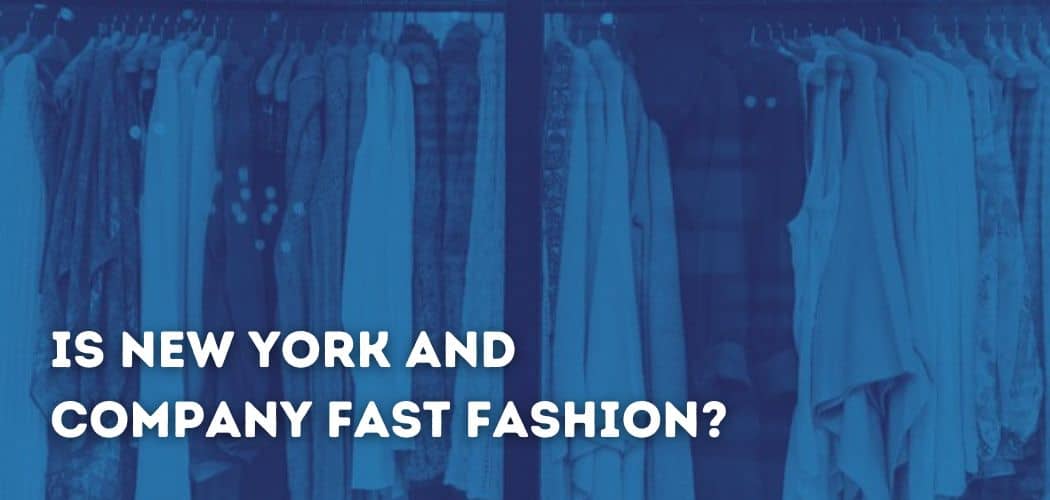To answer the above question, let’s see what a fast-fashion brand is all about.
What is fast fashion?
A fast-fashion brand produces inexpensive clothing in mass volumes. These clothes are made in response to the latest trends.
A fast-fashion brand doesn’t release clothes according to one season. It releases clothes according to 52 micro-seasons.
In simple words, you could say that a fast-fashion brand releases new clothes and celebrates new trends every week of the year.
While this does give customers a huge variety in terms of picking off-the-rack, it also leads to overproduction and overconsumption.
A customer has hardly worn a piece of clothing, or a few items when a new trend emerges, leading to another cycle of overproduction of clothes.
About New York and Company
New York and Company is a fast-fashion company selling men’s and women’s clothing, accessories and shoes.

Its eye-catching designs with colourful vibrant prints are a bit different from other clothing retailers. It sells midi skirts, shirts, jackets, blouses and shorts.
It was founded in 1918 in New York City.
Is it ethical?
Whether a brand is ethical and sustainable or not, can be decided by judging it against a set criterion.
It should:
· Treat its workers well
· Use sustainable materials in its clothing
· Use water, soil and energy resources efficiently
· Use sustainable packaging
· Be transparent regarding its business operations
Most of the brands are not 100% sustainable and according to environmental activists, a fast-fashion brand can never be truly sustainable.
As Lucy Siegle, a journalist specializing in environmental issues says:
“Fast fashion is not free. Someone somewhere is paying the price.”
Water pollution
Most of the clothing at New York and Company uses synthetic materials such as polyester, acrylic, nylon and viscose.
The problem with synthetic materials is that they are non-biodegradable, synthetic and take a long time to decompose. Nylon, for instance, is hard to recycle and ultimately hard to decompose. Most of the landfills accumulate due to this. More than 10.6 million tons of textiles were discarded in US landfills in the year 2014.
Not only this but synthetic materials also pollute the water bodies. The waste products from the dyes are released into streams and waterways.

Another way that synthetic materials harm is through microplastic pollution.
Clothes made of polyester released a great number of microfibers. According to a study, around 9.25 to 15.86 million tons of microplastics can be found on the ocean floor.
These microfibres are ingested by marine life and ultimately enter our food chain!
New York and Company’s website however has no clear policy on reducing water wastage.
Carbon emissions
Since the clothing uses synthetic materials, it also leads to carbon emissions. Plastics are made from Liquid Petroleum Gases (LPG), Natural Gas Liquids (NGL), and natural gas.
It is a shocking fact that 70 million barrels of oil are used just for the manufacturing of polyester.
In this regard, we don’t see any policy by New York and Company about reducing its carbon footprint.

Considering that many brands such as Microsoft, Walmart and IKEA have committed to set science-based targets to reach net-zero emissions before 2050, New York and Company could also strive to be one.
And it is not just tech organizations like Microsoft. Fashion brands like Nike are also playing their part in reducing their carbon footprint. It reuses existing plastic to significantly reduce its carbon emissions.
Violation of labour laws
Many times, fast-fashion brands ignore labour laws, in their race to hurry toward the latest trends and the haste to produce low-cost clothing.
One such example is from 2013 when 1123 garment workers died in the collapse of the Rana Plaza building in Dhaka, Bangladesh. This building housed five garment factories.
Some of the fashion brands in the Rana Plaza were huge names in the fashion industry. They were Walmart, The Children’s Place and Primark.
This wasn’t the only incident. Just 5 months later another tragic incident occurred where at least 112 workers lost their lives, trapped in the building Tazreen Fashions factory on Dhaka’s outskirts.
Many fashion brands outsource their manufacturing processes to countries like India, Bangladesh and China. Here, the minimum wage lies between half to a fifth of the living wage.
International Labour Standards, have given workers basic rights, provided job security and improved their terms of employment.
However, we see no such dedicated labour policy on New York and Company’s website. We neither know the minimum wage paid by New York and Company, nor how dedicated it is to provide safe working conditions.
Where does it get their clothes?
New York and Company have headquarters in New York. However, its website and other official social media platforms do not provide any information regarding its suppliers.

The company is not transparent regarding its business operations.
This leads us to believe that like several other fashion brands, New York and Company too, outsources its manufacturing operations to countries like India, China, and Bangladesh, to cut down on its costs.
